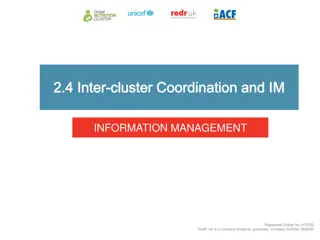
Intro to PERFORMs Cluster and Linux Commands
Discover the basics of a cluster environment, Linux commands, and data organization on a file server. Learn about compute nodes, workstations, data centers, domain computers, storage, and more in this informative guide.
Download Presentation

Please find below an Image/Link to download the presentation.
The content on the website is provided AS IS for your information and personal use only. It may not be sold, licensed, or shared on other websites without obtaining consent from the author. If you encounter any issues during the download, it is possible that the publisher has removed the file from their server.
You are allowed to download the files provided on this website for personal or commercial use, subject to the condition that they are used lawfully. All files are the property of their respective owners.
The content on the website is provided AS IS for your information and personal use only. It may not be sold, licensed, or shared on other websites without obtaining consent from the author.
E N D
Presentation Transcript
Intro to PERFORMs Cluster April 2021 By: Thomas Beaudry
A very very brief intro to linux commands Directory listing: username@perf-hpc01:~$ ls Change directory: username@perf-hpc01:~$ cd example Write text to a new/old file: username@perf-hpc01:~$ echo "some text" >> file1.txt Rename file: username@perf-hpc01:~$ mv file1.txt newFile.txt Make directory (folder): username@perf-hpc01:~$ mkdir subdir Copy file: username@perf-hpc01:~$ cp newFilename.txt subdir/ Change directory: username@perf-hpc01:~$ cd subdir Read file: username@perf-hpc01:~$ cat newFile.txt Search file for word: username@perf-hpc01:~$ cat newFile.txt | grep "text" Delete file: username@perf-hpc01:~$ rm newFile.txt What folder am I in?: username@perf-hpc01:~$ pwd
What is a cluster? A series of connected machines What machines are connected to our cluster? 12 compute nodes. 23 researcher workstations What is a compute node? A powerful server used to process data that is in a server room that doesn t have a monitor (perf-hpc01 through perf-hpc12) What is a workstation? A powerful desktop computer owned by a PI (Primary Investigator a faculty researcher)
What is a data center? A very cold air-conditioned locked room where all our servers are located (Concordia has two, one each at SGW and Loyola campus) What is a domain computer? A machine that is joined to Concordia's domain. Signs that it s joined: If you can login with your Netname, If the output from realm list is concordia.ca * If you are joined you don t need to type .concordia.ca when connecting to a box What is storage? Where data is stored (hard drives) Local vs Remote storage? Local: On the hard drive that you are using Remote: Our file server
File Server Over 100 TB of storage Access is only through Netname accounts What s on it? /NAS, home folders, modules, project & PI folders Servers, workstations, imaging archiving servers Not fully in our control Slower than a local hard (especially MATLAB!) We have a backup one downtown
File Server Data organization Home: /NAS/home Project: /NAS/Projects PI: /NAS/PI What s in a Project folder? username@perf-hpc01:/NAS/Projects/10000001$ ls Data Documentation Notes Protocols Imaging data: /NAS/Projects/<projectNum>/Data/DICOM/PET /NAS/Projects/<projectNum>/Data/DICOM/MRI /NAS/Projects/<projectNum>/Data/MRS/ (data is in there, and OpenMRS output in outputs)
User Accounts Local Account vs Network account Local: An account that exists only on your machine Pro: If the file server is unresponsive you can still use your computer Con: running jobs on the cluster requires lots of manual setup, only exists on 1 machine, separate home folders Network: A Netname account Pro: connect to any machine, share your home folder across the machines Con: user identity is managed by Concordia name server
Connecting remotely to the cluster From linux & OSX: ssh netname@perform-hpc ssh -XY netname@perform-hpc Type: goto_execution_node to be sent to a machine that s load isn t too heavy * or setup x2go if you want a remote desktop experience (But specify a machine name i.e. perf-imglabXX) (if you want to use graphical programs) From windows: Use mobaxterm (https://mobaxterm.mobatek.net/download.html) and use the same linux commands
Connecting remotely to the Cluster - X2Go X2Go is a remote Desktop software That can be used Instead of ssh
Copying files From your workstation Regular cp commands work since the file server is automatically mounted From a computer not joined to our domain to a node Copy to a file from a path to your home folder on the server: scp /filePath/myFile.txt yourNetname@perform-hpc: Copy a file from the the directory you are in to a specific path on the server: scp myFile.txt yourNetname@perform-hpc:/NAS/Projects/9000080/ If you are copying a directory you need scp -r From the server to your local computer? scp awesome.txt localUser@computerName_or_IP_address: An alternative to scp would be to use a 3rd party graphical software like filezilla: https://filezilla-project.org/
Using the Cluster: Modules To see which modules (software packages) are available: module avail To load a software / package: module load <moduleName>/<version> (if no version is specified it will use the default) To see which modules you have active: module list To unload a module: module unload <module> To unload all loaded modules: module purge
Scheduler What is it? A service that takes job requests and finds an available machine to process it. Allowing for parallelization of jobs. Which one do we use? SGE (Son of Grid Engine) Anything else to know about it? PERFORM-HPC is the server that runs the scheduler. Hence, it can t process data
Submitting jobs From within a script: #####example of a script resampleimage.sh #!/bin/bash qsub -j y -o logs/mnc_out.txt -V -cwd -q all.q -N mncresample <<END mincresample /path/to/image/file.mnc -like /path/to/image/template.mnc out.mnc END Important: is the output of the job. Make sure that the logs folder exists -o logs/mnc_out.txt is the queue that you are submitting the job to -q all.q is the name displayed in the queue -N mncresample Optional: -pe smp <num_cores> reserves <num_cores> which is a number from 1-32 -l h_vmem=<num>G reserves <num> GB of RAM, i.e. -l h_vmem=12G reserves 12GB From the comand line: qsub -j y -o logs/mnc_out.txt -V -cwd -q all.q -N mncresample ./resampleimage2.sh
Monitoring jobs perform-admin@perf-hpc01:~$ qstat -f queuename qtype resv/used/tot. load_avg arch states --------------------------------------------------------------------------------- all.q@perf-hpc02.concordia.ca BIP 0/0/32 0.21 lx-amd64 ------------------------ --------------------------------------------------------- all.q@perf-hpc03.concordia.ca BIP 0/0/32 0.07 lx-amd64 ################################################################# PENDING JOBS - PENDING JOBS - PENDING JOBS - PENDING JOBS ################################################################# 13269 0.55500 mnc_hpc03 perform-admi qw 04/11/2019 11:57:38 1 13279 0.55500 mnc_imglab perform-admi qw 04/11/2019 11:57:38 1 13280 0.55500 mnc_imglab perform-admi qw 04/11/2019 11:57:38 1
Useful Commands Delete: Delete all your jobs: qdel -j <job number> qdel -u <username> Check job status (used for errors): qstat -j <job_number> Summary of how busy the cluster is: qstat -g c CLUSTER QUEUE CQLOAD USED RES AVAIL TOTAL aoACDS all.q matlab.q ------------------------------------------------ 0.02 0 0 352 466 0 114 0.02 0 0 192 192 0 0 cdsuE qstat -f -u \* See everyone s job activity:
Example of dealing with errors: $qstat -f ################################################################## - PENDING JOBS - PENDING JOBS - PENDING JOBS - PENDING JOBS - PENDING JOBS ################################################################## 13382 0.55500 mnc_hpc01 perform-admi Eqw 04/12/2019 12:11:56 1 $qstat -j 13382 error reason 1: 04/12/2019 12:12:08 [1661213601:5373]: error: can't open output file "/NAS/home/perform-admin/logs/mnc_out.txt": No such file or directory
Submitting to specific hosts The following script is a good example at how you can specify specific hosts to submit to. #!/bin/bash #perf-hpc01 through 12 for num in {1..12} do if [ ${num} -lt 10 ] #make sure num is 2 digits then num=0${num} fi queue=all.q@perf-hpc${num} qsub -j y -o logs/mnc_out.txt -V -cwd -q $queue -N mnc_hpc${num} <<END mincresample /util/packages/minc-toolkit/1.9.11/minc-itk4/icbm_segmented_masked.mnc - like /util/packages/minc-toolkit/1.9.11/minc-itk4/icb$ echo $HOSTNAME END done






















